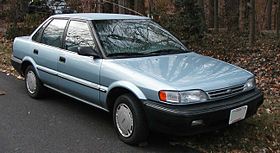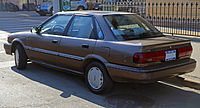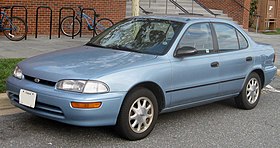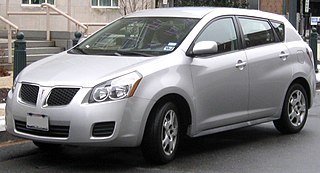
The Pontiac Vibe is a compact car that was sold by Pontiac from 2002 to 2010. It was jointly developed by General Motors along with Toyota, which manufactured the mechanically similar Toyota Matrix. Manufactured by the Toyota-GM joint venture NUMMI in Fremont, California, the Vibe succeeded the Chevrolet Prizm in production at NUMMI and like the Prizm, it was derived from the Toyota Corolla, making it the last of the GM and Toyota developed S-body cars.
Geo was a brand of small cars marketed by General Motors (GM) as a subdivision of its Chevrolet division from 1989 to 1997.

In the automotive industry, rebadging is a form of market segmentation used by automobile manufacturers around the world. To allow for product differentiation without designing or engineering a new model or brand, a manufacturer creates a distinct automobile by applying a new "badge" or trademark to an existing product line.

The Toyota Corolla is a series of compact cars manufactured and marketed globally by the Japanese automaker Toyota Motor Corporation. Introduced in 1966, the Corolla was the best-selling car worldwide by 1974 and has been one of the best-selling cars in the world since then. In 1997, the Corolla became the best-selling nameplate in the world, surpassing the Volkswagen Beetle. Toyota reached the milestone of 50 million Corollas sold over twelve generations in 2021.
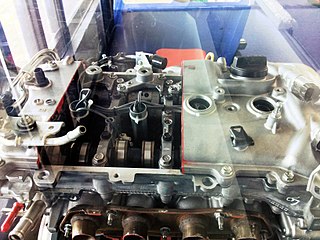
VVT-i, or Variable Valve Timing with intelligence, is an automobile variable valve timing technology developed by Toyota. It was introduced in 1995 with the 2JZ-GE engine found in the JZS155 Toyota Crown and Crown Majesta.

The Toyota A Series engines are a family of inline-four internal combustion engines with displacement from 1.3 L to 1.8 L produced by Toyota Motor Corporation. The series has cast iron engine blocks and aluminum cylinder heads. To make the engine as short as possible, the cylinders are siamesed.

The Geo Metro was a marketing and manufacturing variation of the Suzuki Cultus available in North America from 1989 through 2001 as a joint effort of General Motors (GM) and Suzuki. In the US, the Metro carried a Geo nameplate from 1989 through 1997, and a Chevrolet nameplate from 1998 to 2001. It evolved with the Cultus and its siblings over 13 years, three generations and four body styles: three-door hatchback, four-door sedan, five-door hatchback and two-door convertible—and was ultimately replaced in the General Motors lineup by a family of vehicles based on the Daewoo Kalos, the Chevrolet Aveo.

The Chevrolet Chevy II/Nova is a small automobile manufactured by Chevrolet, and produced in five generations for the 1962 through 1979, and 1985 through 1988 model years. Built on the X-body platform, the Nova was the top selling model in the Chevy II lineup through 1968. The Chevy II nameplate was dropped after 1968, with Nova becoming the nameplate for all of the 1969 through 1979 models. It was replaced by the 1980 Chevrolet Citation introduced in the spring of 1979. The Nova nameplate returned in 1985, produced through 1988 as a S-car based, NUMMI manufactured, subcompact based on the front wheel drive, Japan home-based Toyota Sprinter.

The Toyota Sprinter is a compact car manufactured by Toyota as a variant of the Toyota Corolla. Exclusively sold in the Japanese domestic market, the Sprinter was aimed to be sportier than its Corolla sibling and also using different sheet metal mostly on the C-pillar. The Sprinter was sold exclusively at the Toyota Auto Store while the Corolla was sold at the eponymous Toyota Corolla Store, which focused on economical cars compared to the more upmarket Vista store.

The Toyota ZZ engine family is a straight-4 piston engine series. The ZZ series uses a die-cast aluminium engine block with thin press-fit cast iron cylinder liners, and aluminium DOHC 4-valve cylinder heads. The camshafts are chain-driven. The two 1.8 L members of the family, the 1ZZ and 2ZZ, use different bore and stroke. The former was optimised for economy, with torque emphasised in lower revolutions per minute operating range, while the latter is a "square" design optimised for high-RPM torque, yielding higher peak power. The ZZ family replaced the extremely popular cast-iron block 4A engines.
Toyota Motor Corporation's A family is a family of automatic FWD/RWD/4WD/AWD transmissions built by Aisin-Warner. They share much in common with Volvo's AW7* and Aisin-Warner's 03-71* transmissions, which are found in Suzukis, Mitsubishis, and other Asian vehicles.

The Suzuki Cultus is a supermini car produced by the Japanese manufacturer Suzuki from 1983 to 2016. The nameplate is currently used as a rebadged second-generation Suzuki Celerio in Pakistan since 2017. It was first presented at the 25th Tokyo Motor Show, formally introduced to Japan in 1983 and ultimately sold in seven countries across three generations and marketed worldwide as the Suzuki Swift for the first two generations. An alliance formed in 1981 between General Motors, Suzuki and Isuzu allowed GM to market the Cultus as a captive import internationally under more than a dozen nameplates including the Geo Metro, Chevrolet Sprint, Pontiac Firefly and Holden Barina. It was also known as the M-car within GM.
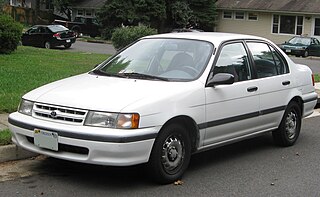
The Toyota Tercel is a subcompact car manufactured by Toyota from 1978 until 1999 across five generations, in five body configurations sized between the Corolla and the Starlet. Manufactured at the Takaoka plant in Toyota City, Japan, and sharing its platform with the Cynos and the Starlet, the Tercel was marketed variously as the Toyota Corolla II — sold at Toyota Japanese dealerships called Toyota Corolla Stores — and was replaced by the Platz in 1999. It was also known as the Toyota Corsa and sold at Toyopet Store locations. Starting with the second generation, the Tercel dealership network was changed to Vista Store, as its badge engineered sibling, the Corolla II, was exclusive to Corolla Store locations.
United Australian Automobile Industries (UAAI) was an automobile model sharing firm that operated in Australia between 1987 and 1996 as the result of an agreement between Holden and Toyota Australia. The joint venture resulted in the two companies sharing production of locally produced automobiles by selling their models under both brands.

The Corolla E90, introduced in 1987 for the 1988 model year, was the sixth generation of cars sold by Toyota under the Corolla nameplate. It was the last generation of Corolla to be classified as a subcompact car and the first to be exclusively front-wheel drive or all-wheel drive; the performance option of rear-wheel drive was dropped.

The Corolla E100 was the seventh generation of cars sold by Toyota under the Corolla nameplate. This generation of Corolla was larger, heavier, and visually more aerodynamic than the model it replaced. With its 2,465 mm (97.0 in) wheelbase, the Corolla had moved into the compact size class once occupied by the Corona and Camry. The Corolla again had an equivalent model Sprinter, with the Sprinter Trueno being equivalent to the Corolla Levin and both exclusive to Toyota Vista Store Japanese dealerships.
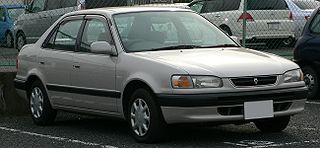
The Corolla E110 was the eighth generation of cars sold by Toyota under the Corolla nameplate.
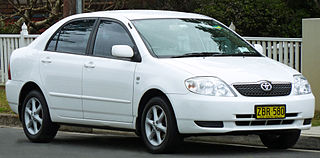
The Toyota Corolla (E120/E130) is the ninth generation of compact cars sold by Toyota under the Corolla nameplate. In Japan, this series arrived to the market in August 2000; however, exports were typically not achieved until 2001 and 2002 depending on the market.

The Toyota Corolla E80 is a range of small automobiles manufactured and marketed by Toyota from 1983 to 1987 as the fifth generation of cars under the Corolla and Toyota Sprinter nameplates, with production totaling approximately 3.3 million, and most models adopting a front-wheel drive layout.

The Toyota Sprinter Trueno is a series of compact sports coupés and hot hatches which were produced by Toyota from 1972 to 2000. The name Trueno in Spanish means thunder. In Japan, the Sprinter Trueno was exclusive to Toyota Auto Store locations, later renamed Toyota Vista Store in 1980.

